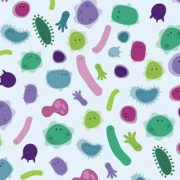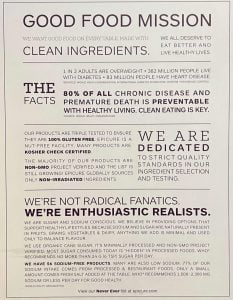Do Antibiotics in Childhood Increase the Risk Factor for Celiac Disease?
 Mayo Clinic researchers suspect antibiotics can sometimes kill off ‘good’ bacteria in the digestive tract, potentially affecting the development of important bodily functions.
Mayo Clinic researchers suspect antibiotics can sometimes kill off ‘good’ bacteria in the digestive tract, potentially affecting the development of important bodily functions.
- by Tracey Romero, PhillyVoice Staff 1
Young children who are treated with antibiotics before age 2 are more likely to develop allergies, asthma and other health issues [including celiac disease] later in childhood than other children, according to a new study.
About 70% of the children involved in the study had received at least one antibiotic treatment for an illness before age 2, Mayo Clinic researchers found.
The Study: Association of Infant Antibiotic Exposure With Childhood Health Outcomes
Objective
- To investigate the extent to which antibiotic exposure in the first 2 years of life is associated with the risk of immunological, metabolic, and neurobehavioral health conditions with childhood onset.
Patients and Methods
- In this population-based cohort study, we identified all children born in Olmsted County, Minnesota, between January 1, 2003, and December 31, 2011, through the Rochester Epidemiology Project medical records-linkage system. Demographic characteristics, antibiotic prescriptions, and diagnostic codes through June 30, 2017, were retrieved using the Rochester Epidemiology Project infrastructure. Time-to-event analysis was performed to assess the impact of antibiotic exposure on the risk of several adverse health conditions.
Results
- This study included 14,572 children (7026 girls and 7546 boys), of whom 70% (10,220) received at least 1 antibiotic prescription during the first 2 years of life.
- Early antibiotic exposure was associated with an increased risk of childhood-onset asthma, allergic rhinitis, atopic dermatitis, celiac disease, overweight, obesity, and attention deficit hyperactivity disorder (hazard ratios ranging from 1.20 to 2.89; P<.05 for all).
- The associations were influenced by the number, type, and timing of antibiotic exposure. Moreover, children exposed to antibiotics had a higher probability of having combinations of conditions, particularly when given multiple prescriptions.
Conclusion
- The present study finds significant associations between early life antibiotic exposure and several distinct health conditions with childhood onset. Additional research is warranted to establish practical guidelines to optimize the benefit and minimize the risk of antibiotics in children.
Health issues linked to early use of antibiotics included asthma, allergic rhinitis, weight issues and obesity, food allergies, attention deficit hyperactivity disorder, celiac disease and atopic dermatitis.
Multiple antibiotic treatments were associated with the development of multiple conditions. The illnesses varied depending on the child’s gender, age, type of medication, dose and number of doses.
“We want to emphasize that this study shows associations, not causations, of these conditions,” senior study author Nathan LeBrasseur, a researcher at Mayo Clinic’s Center of Aging, said in a statement.
“These findings offer the opportunity to target future research to determine more reliable and safer approaches to timing, dosing and types of antibiotics for children in this age group.”
The researchers theorize that the antibiotics disrupt the bacteria in a young child’s gut by killing off some of the so-called “good” bacteria necessary for the development of important bodily functions.
Children are prescribed almost 7 million antibiotic prescriptions in emergency departments every year, according to a 2019 study published in the Journal of the American Academy of Pediatrics.
In many of these cases, the child’s illness didn’t require antibiotic treatment. For example, colds and most sore throats are caused by viruses and will not respond to an antibiotic.
The Mayo Clinic researchers found that multiple courses of antibiotics at a young age may affect the development of important systems in the body, including the immune and metabolic systems.
- The data showed that girls who received one to two treatments were at significantly higher risk to develop asthma and celiac disease compared to those who never had any antibiotics.
- However, when the number of prescriptions jumped to three or four, both sexes had a higher incidence rate of asthma, atopic dermatitis and being overweight.
- Girls in this higher category were also more likely to develop ADHD and celiac disease. The boys were more likely to be obese.
- At five or more prescriptions, all of the children were at significantly higher risk for asthma, allergic rhinitis, being overweight, obesity and ADHD. Girls were also at higher risk of developing celiac disease.
Two of the most commonly prescribed antibiotics to be linked to many of these health conditions are penicillin and cephalosporin.
For the study, the researchers analyzed health record data from over 14,500 children enrolled in the Rochester Epidemiology Project, a population-based research collaboration in Minnesota and Wisconsin.
The results of the study were surprising, the researchers said, and would need to be confirmed in future studies.
Antibiotics have largely been considered safe by most pediatricians, but overuse also has led to antibiotic resistance and the development of “superbugs.”
These bacteria are resistant to the antibiotics prescribed, making them especially dangerous, pediatric experts say. A particularly hard one to treat is Methicillin-resistant Staphylococcus, known simply as MRSA.
The U.S. Centers for Disease Control and Prevention says antibiotic resistance is a serious national public health concern. Each year, at least 2.8 million people develop an antibiotic-resistant infection, and more than 35,000 people die from it.
SOURCE ARTICLE: https://www.mayoclinicproceedings.org/article/S0025-6196(20)30785-0/fulltext













